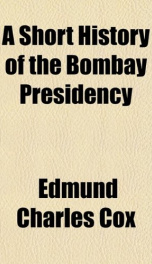a short history of the bombay presidency

Purchase of this book includes free trial access to www.million-books.com where you can read more than a million books for free. This is an OCR edition with typos. Excerpt from book: .iud after the rains their streams and waterfalls, leaves nothing to be desired by the lover of nature, except a climate that will allow him to enjoy the beanty that meets his eye. Generally speaking, the rivers of the Deccan are raging torrents for a few months of the year, and not much more than lry beds for the rest. But near the coast the rivers are for the most part tidal streams, and are much used for navigation ; while they afford fertility to the picturesque country through which they take their course. Next to the Indus, the most important rivers that fall into the Western Ocean are the Narbada and Tiipti, that flow half across India from the Central Provinces and empty themselves into the sea at Broach and Surat in Guzdrat. Of those that take the contrary course from the Ghats to the Bay of Bengal the chief are the Godawari and the Krishna, with its tributary the Bhima. Towns and villages are met with every few miles, those in the Deccan having strong walls that were once needed for their protection. The people have ever sought the security that a community affords, and the traditional custom has survived after its necessity has disappeared. Farmhouses and cottages scattered about like those in England are never to be seen in India. Four languages besides Hindustani are spoken in the Presidency. In Sind the language is Sindi, in which the Persian and Hindustani elements predominate ; in Guzarat Guzarati, the language spoken by the Parsis, in which a Persian colouring is laid upon a Sanskrit foundation ; in the Konkan. and the Deccan, except in the extreme south and east, Marathi, which, of all Indian languages, bears the closest resemblance to the Sanskrit from which it has sprung, the characters in which it is written being almost unaltered. The country in which M...
Info about the book
Author:
Series:
Unknown
ISBN:
1444626922
Rating:
4/5 (3)Your rating:
0/5
Languge:
English
Users who have this book
Users who want this book
What readers are saying
What do you think? Write your own comment on this book!
write a commentif you like a short history of the bombay presidency try:
Other books by this author
Do you want to exchange books? It’s EASY!
Get registered and find other users who want to give their favourite books to good hands!


